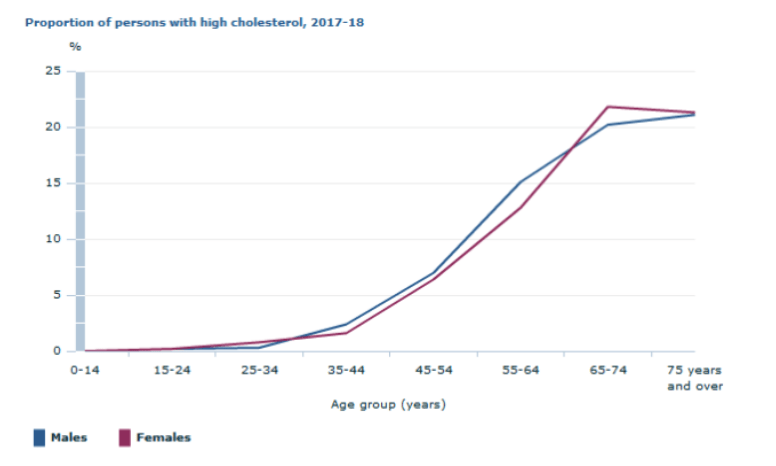About Hyperlipidaemia
Hyperlipidaemia (also commonly referred to as Dyslipidaemia) is a condition that refers to an abnormal level of total cholesterol, including Low-density lipoprotein (LDL-C), High-density level lipoprotein (HDL-C) or triglycerides (TG), or all concurrently.
It may also refer to a lower than normal level of high-density lipoprotein cholesterol (HDL-C) levels. Either form may increase the risk of atherosclerosis, which can, in turn, increase the risk of cardiovascular disease in these patients.
Prevalence of Hyperlipidaemia
The Australian Bureau of Statistics suggests in 2017/18 that as many as “6.1% of all Australians had high cholesterol levels,” this total approximates to 1.5 million people in Australia. It further suggests that the condition may be shared equally amongst men and women and increases with age from 6.8% of the population aged 45-54, to over 1 in 5 (20%) in those over the age of 65.1

Economic Burden of Hyperlipidaemia
In 2017/18 the estimated economic cost attributed to Hyperlipidaemia was in excess of $3.9 billion. The costs associated with high cholesterol levels comprise of two main areas:
- The economic costs associated with the diagnosis and treatment of the disease, and
- The economic costs associated with the diseases caused by Hyperlipidaemia.
The actual costs may be underrepresented as Hyperlipidaemia is a risk factor for ischaemic heart disease and ischemic stroke. Hyperlipidaemia may be attributed to up to 51% of patients with heart disease and 12% of patients who suffer an ischaemic stroke.
High cholesterol levels are also involved in the development of Peripheral Vascular Disease (PVD). This can lead to further significant problems such as peripheral neuropathies and limb vascular compromise, which can cause serious complications of the affected limbs.3
What is Hyperlipidaemia?
Risks Associated with Hyperlipidaemia
Patients who have been diagnosed with Hyperlipidaemia are at risk of developing:
- Atherosclerosis (narrowing of the arteries due to plaque build-up),
- Ischaemic heart disease (IHD) leading to heart attacks,
- Stroke / transient ischaemic attack, and
- Peripheral vascular disease (PVD).4
Coronary Heart Disease, Clogged Arteries and Atherosclerosis
Classification of Hyperlipidaemia
There are three main classifications of Hyperlipidaemia:
- Increased cholesterol levels only (also called isolated cholesterolaemia),
- Increased triglyceride levels only (isolated hypertriglyceridemia), and
- Increased levels of both cholesterol and triglycerides (mixed or combined hyperlipidemia).5
Causes of Hyperlipidaemia
There are two main categories for Hyperlipidaemia:
- Inherited / genetic – this category refers to a genetic alteration that can be found in between 40-60% of patients with Dyslipidaemia, highlighting that there can be multiple family members with the condition. This condition is often referred to as Familial Hypercholesterolaemia and can affect the method that the body recycles high-density lipoprotein (HDL) and low-density lipoprotein (LDL)
- HDL’s assist in the transportation of cholesterol to the liver, and also the removal of excess cholesterol through normal liver function. This can be referred to as “good cholesterol.”
- LDL’s assist in transporting cholesterol to the heart, and may collect in the arterial walls of the coronary vessels, and can cause atherosclerosis or plaque build-up in the arteries. This can lead to blood clots forming in the arteries and can increase the risk of heart disease, heart attack and stroke. LDL’s can be referred to as “bad cholesterol.”6

- Secondary causes are often referred to as “lifestyle” causes of Hyperlipidaemia. They can include:
- Diabetes mellitus,
- Alcohol abuse,
- Endocrine disorders such as Hypothyroidism,
- Chronic kidney disease/failure,
- Liver dysfunction,
- Some medication side effects may lead to abnormal cholesterol levels,
- High fatty diet,
- Obesity, and
- Reduced exercise/activity.8
Learn more about the diagnosis of Hyperlipidaemia
